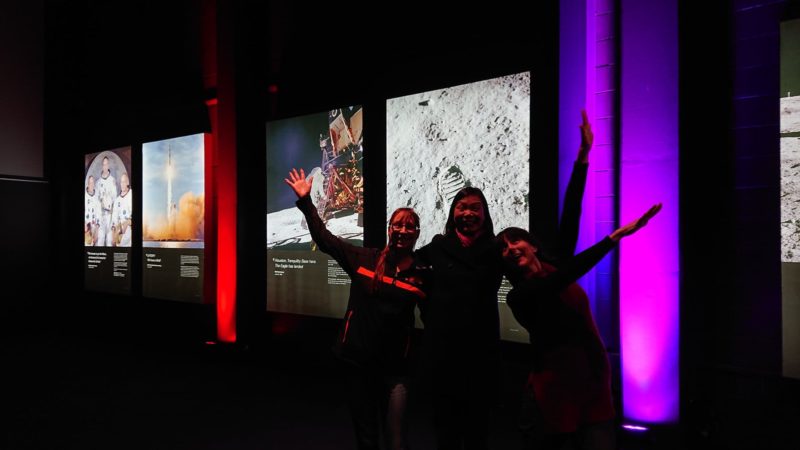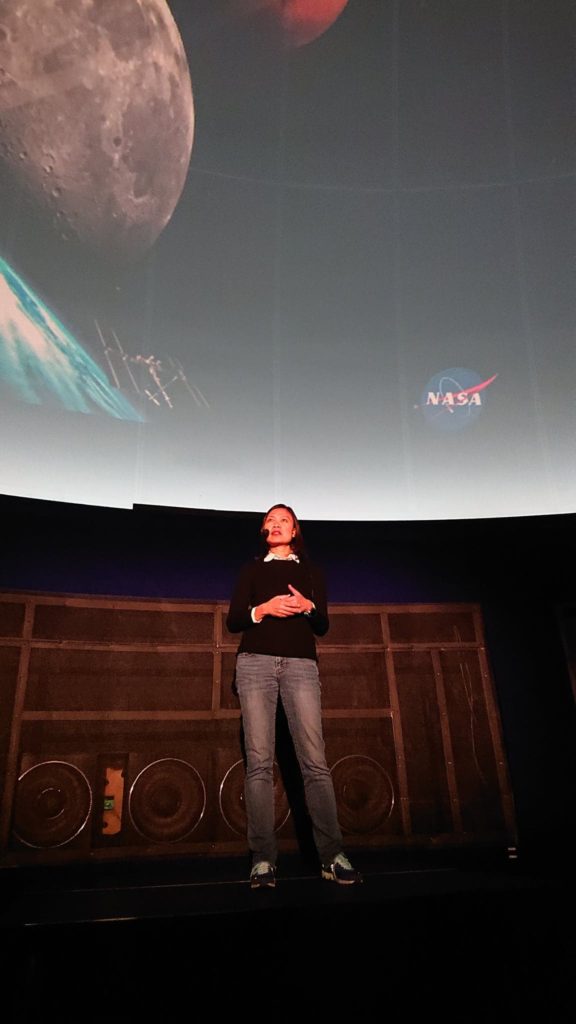Space on Earth

Photo: Dr Renee Beale, Science Week Victoria Lead; Dr Darlene Lim, NASA; Kate Barnard, Museums Victoria’s Science Programs Manager.
Darlene Lim aims to “merge science and exploration”. NASA’s vision is to get more humans to Moon and beyond, and this time they might stay there for hundreds of days, investigating rocks, the landscape, and the possibility of past life. In all the planning, preparations and discussions, Darlene wants scientific discovery at the forefront.
When people explore space, there is an abundance of data and materials to collect that can be shared across a broad range of scientific fields – some that may not yet exist. As an example, lunar rocks were collected 50 years ago and are still studied to this day. It can be difficult to design extravehicular activities (EVAs) that are done by astronaut or cosmonauts outside a spacecraft as we like to have control from moment to moment, especially if the lead scientists do not go out into the field and are reliant on others collecting data for them.
One of the greatest challenges is the communication delay. Mars is so far away that it takes radio signals between 4 and 24 minutes to travel from a spacecraft back to Earth. This makes it difficult to have a conversation and react if anything goes wrong: if there is a problem on the spacecraft, mission control on Earth won’t know for an average of 13 minutes, and even if they respond straight away, it will be a further 13 minutes before their instructions get back to Mars. A lot can happen in that time.
Darlene and her team use analog missions to approximate extreme environments. Not all experiments can be done in space – there is not enough time, money, equipment, or manpower. So analogs are the next best thing – and we can learn more about Earth at the same time. From the top of volcanoes to the depths of the ocean, deserts, and the Antarctic and arctic, Darlene and other NASA scientists are preparing for deep space destinations.
Analog missions have been used for over 50 years. The astronauts who prepared for the Moon Landing went to test sites in Arizona in a “geology field school” to learn about different rocks so that they were able to determine the most valuable lunar rocks to collect.
Darlene leads an international team of scientists, engineers, mission operators and astronauts who are preparing for the exploration of Mars with analogs. The BASALT (Biologic Analog Science Associated with Lava Terrains) research team undertakes fieldwork in Idaho and Hawai’i to understand the habitability of terrestrial volcanic terrains as analog environments for early and present-day Mars.
During analog missions, the team learns how to make decisions and coordinate communications. Two astronauts go out into the field and communicate directly with others who are in “Mars time”, representative of those who remain in a spacecraft for support. Any communication between the spacecraft and mission support centre in “Earth time” is delayed – all messages between mission control and the simulation spacecraft are buffered for 10-15 minutes before they are received at the other end. With these models, the team can iron out any kinks in preparation for the real thing on Mars.
The team has also created virtual reality (VR) and augmented reality programs so that astronauts are armed with more support to make up for the communication lag. VR allows astronauts to walk through a virtual site to get a grasp of what types of things are of most value to explore before being alone in a desolate environment. Augmented reality allows mission support centres to outline the safest paths and guide astronauts to particular objectives in real time (i.e. to a particular formation of rocks that might be of interest based on data readings). These advances in technology are certainly a leap from 1969.
Darlene also leads NASA’s SUBSEA (Systematic Underwater Biogeochemical Science and Exploration Analog) research program. In deep space voyages, it is likely that astronauts will be controlling remote operated vehicles (ROVs) on the surface of inhospitable planets while remaining in orbit. In a simulation of that situation, the team uses ROVs to explore volcanic seamounts up to 4000m below the ocean’s surface while on-board the ship, Nautilus. The ROVs send data to the ship, who then transmit information back to a support team on land. This gives them the chance to test new technologies, robotic equipment, and communication support while still on Earth when the cost isn’t as great when things go wrong.
Analogs provide NASA with data about the strengths, limitations, and the validity of planned space exploration operations. Space is an dangerous, unfriendly place, but it also holds the answers to so many questions – some that haven’t even been asked yet. Darlene wants to keep humanity in space travel. Space travellers should be able to be human: to investigate and interrogate the landscape but being able to laugh, make mistakes, and exclaim their excitement. The more problem-solving we do here on Earth, the better prepared we will be when we head to asteroids, Mars, the Moon, and beyond.

